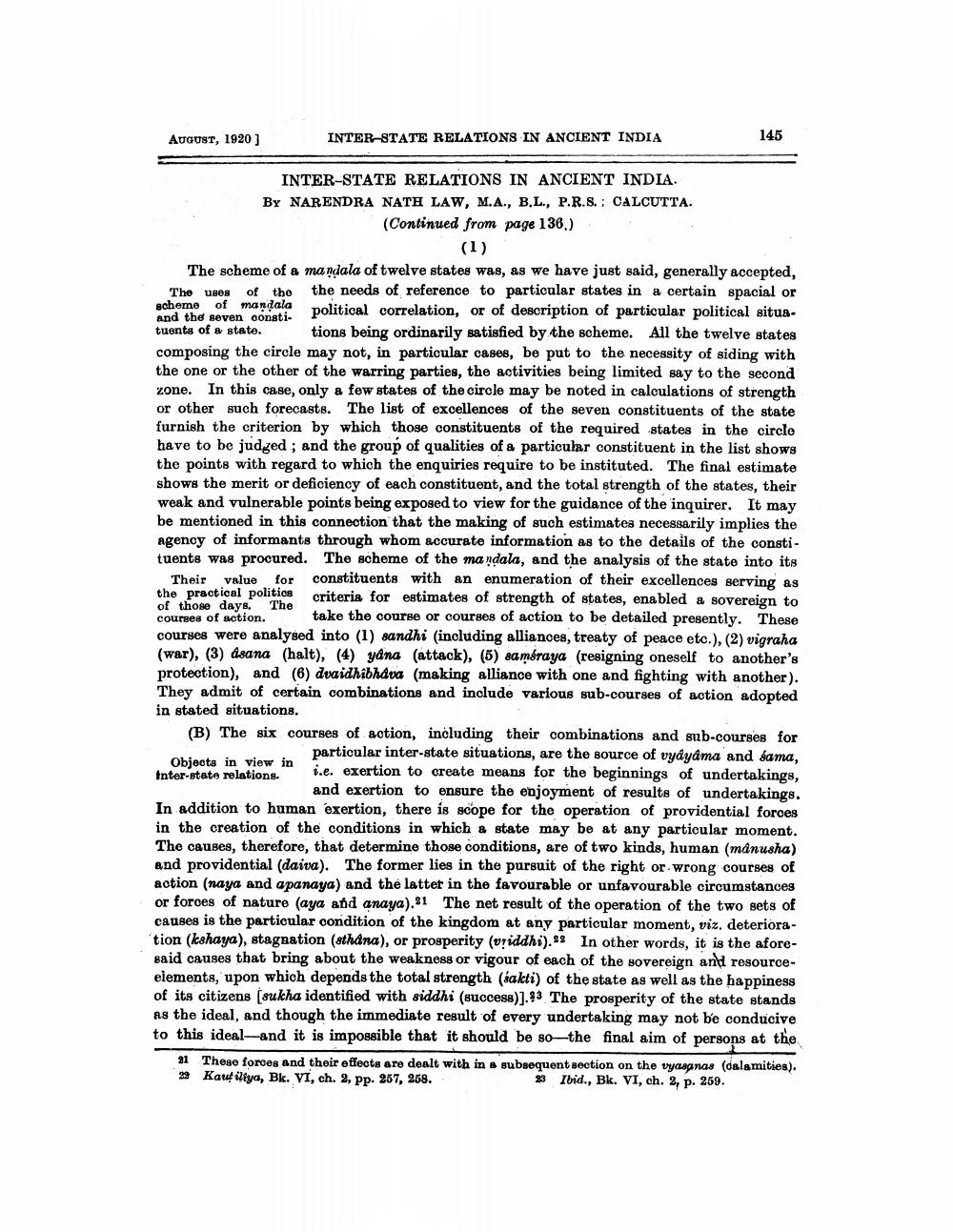________________
INTER-STATE RELATIONS IN ANCIENT INDIA
AUGUST, 1920 ]
145
INTER-STATE RELATIONS IN ANCIENT INDIA. BY NARENDRA NATH LAW, M.A., B.L., P.R.S.: CALCUTTA.
(Continued from page 136.)
(1) The scheme of a mandala of twelve states was, as we have just said, generally accepted, The uses of the the needs of reference to particular states in a certain spacial or scheme of mandala
la
political patio
political correlation, or of description of particular political situa. and the seven oonstituents of a state. tions being ordinarily satisfied by the scheme. All the twelve states composing the circle may not, in particular cases, be put to the necessity of siding with the one or the other of the warring parties, the activities being limited say to the second zone. In this case, only a few states of the circle may be noted in calculations of strength or other such forecasts. The list of excellences of the seven constituents of the state furnish the criterion by which those constituents of the required states in the circle have to be judged ; and the group of qualities of a particular constituent in the list shows the points with regard to which the enquiries require to be instituted. The final estimate shows the merit or deficiency of each constituent, and the total strength of the states, their weak and vulnerable points being exposed to view for the guidance of the inquirer. It may be mentioned in this connection that the making of such estimates necessarily implies the agency of informants through whom accurate information as to the details of the constituents was procured. The scheme of the mandala, and the analysis of the state into its
Their value for constituents with an enumeration of their excellences serving as the practical politics criteria for estimates of strength of states, enabled a sovereign to of those days. The courses of action take the course or courses of action to be detailed presently. These courses were analysed into (1) sandhi (including alliances, treaty of peace etc.), (2) vigraha (war), (3) asana (halt), (4) yana (attack), (5) sambraya (resigning oneself to another's protection), and (6) dvaidhibhdva (making alliance with one and fighting with another). They admit of certain combinations and include various sub-courses of action adopted in stated situations. (B) The six courses of action, including their combinations and sub-courses for
particular inter-state situations, are the source of vydydma and sama, Objects in view in Inter-state relations. 3.e. exertion to create means for the beginnings of undertakings,
and exertion to ensure the enjoyment of results of undertakings. In addition to human exertion, there is scope for the operation of providential foroes in the creation of the conditions in which & state may be at any particular moment. The causes, therefore, that determine those conditions, are of two kinds, human (manusha) and providential (daiva). The former lies in the pursuit of the right or wrong courses of action (naya and a panaya) and the latter in the favourable or unfavourable circumstances or forces of nature (aya and anaya).21 The net result of the operation of the two sets of causes is the particular condition of the kingdom at any particular moment, viz. deterioration (kshaya), stagnation (sthana), or prosperity (vriddhi).22 In other words, it is the aforesaid causes that bring about the weakness or vigour of each of the sovereign and resourceelements, upon which depends the total strength (sakti) of the state as well as the happiness of its citizens (sukha identified with siddhi (success)].3 The prosperity of the state stands As the ideal, and though the immediate result of every undertaking may not be conducive to this ideal--and it is impossible that it should be so the final aim of persons at the
21 These forces and their effects are dealt with in a subsequent section on the vyasanas (dalamities). 22 Kaut ültya, Bk. VI, ch. 2, pp. 257, 258.
33 Ibid., Bk. VI, ch. 2, p. 259.




